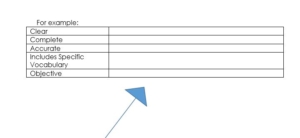Making and Recording Observations
As scientists one of the process skills that we must use is making observations. Why? We must be able to communicate what we have discovered using our senses and tools. “These observations often serve as evidence in the scientific arguments, explanations, and theories of the field. Like scientists, students engage in these practices to learn about the disciplinary core ideas and crosscutting concepts as called for by the Next Generation Science Standards.” (Arias and Davis, 2016)
So… what does it look like when students are making observations? Observations need to have certain characteristics:
• They need to be clear- another scientist may need to use their information later
• They must be complete- students should record all necessary details relevant to the investigation- think senses… Which of the five senses, or all can they observe and record.
• They should be accurate- duh! The observations should be what they actually heard, smelled, or saw… not what they inferred or thought they saw, heard, and smelled.
• Try to be objective- Not that their car rolled far, but how far? Was in 10cm or maybe even 100 cm?
• Observations should be well-labeled and using scientific vocabulary. Remembering again that anybody should be able to interpret their observations.
I know what you’re thinking: “that sounds great but not all students are successful at making observations.” Let me tell you what research says about that: yes, there are struggles. Some of these common struggles are that students think they will remember their observations so why do they have to write them down: Believe me, they will forget! (Don’t let them convince you that they won’t) Students also record inferences rather than observations. You may need to remind students that observations are only things that can be seen, heard, smelled, and touched. Inferences are what they believe is happening based on their observations. One of the other struggles is that students are not recording observations that are clear, complete, and objective. As teachers we need to ensure that we are holding students accountable and have a working plan in place for scoring observations.
This is when rubrics come into the equation. One way to have student buy in with rubrics is to have them help you create the criteria for the rubric.
Have students decide what they think should be the criteria in these boxes. This can change from time to time and may need to be adjusted depending on the goal you have in mind.
Lastly, when you are looking at student’s observations they should be given feedback. If all they do is put their observations in their notebook and nobody ever looks at it, well…. They are pretty clever things and will not be ensuring that they have all the components and criteria that THEY agreed they should have.
Like always, you have to think about the needs of your students and how you are going to meet their needs. Do what is best for your students!!
HAPPY OBSERVING!!
References
Arias, Anna Maria., Davis, Elizabeth A. (2016) Making and Recording Observations. Science & Children (53). Pages 54-60.
